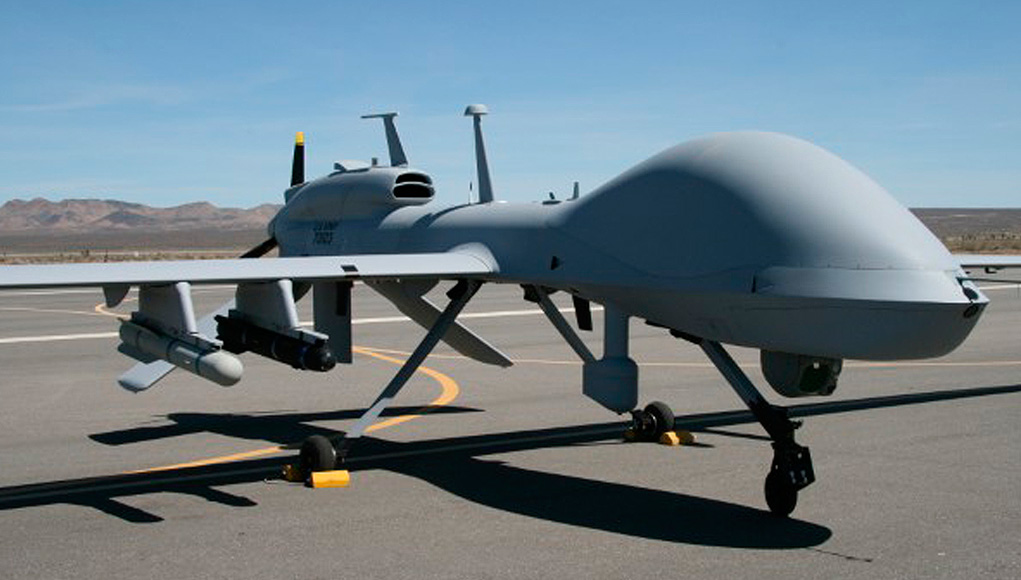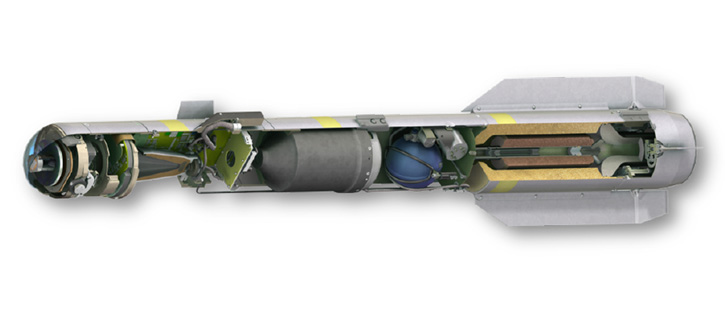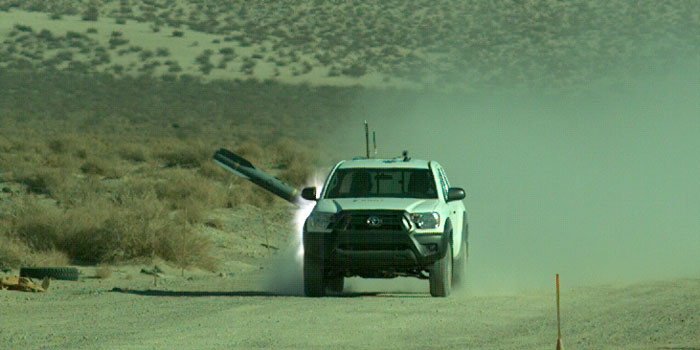
missile bus. When paired with the HELLFIRE II missile bus, JAGM is fully compatible
with all HELLFIRE platforms including this MQ-1C Gray Eagle drone used by the US Army. (Photo: Lockheed Martin)
The US Army has released a Request for Proposals for the Engineering (EMD) and development of the Joint Air-to-Ground Missile (JAGM) – new air/ground missile designed to replace the current air-launched BGM-71 TOW, AGM-114 Hellfire and AGM-65 Maverick missiles. The US Army will offer the winner options for Low Rate Initial Production (LRIP), toward fulfilling the Army and Navy plan to buy thousands JAGM missiles. The Army that has published the RFP in January 2015 plans to award the contract in August this year.
The main advantage of the new missile over the Hellfire will be its dual-mode seeker, adding millimeter-wave (MMW) radar guidance to the Hellfire’s semi-active laser (SAL) guidance. The user can select the missile’s effect from the cockpit, setting the missile’s tandem, shaped charge warhead to deliver armor piercing or blast fragmentation effect. This capability adds fire-and-forget engagement modes to the weapon, significantly increasing the JAGM user survivability against threat defenses in GPS denied and austere communications environments.

The new missile consists of a newly developed Guidance Section (GS) mated to the existing HELLFIRE Romeo backend (motor, warhead and associated electronics). Compatible with the current Hellfire AGM-114R, JAGM will be used with AH-64D/E Apache and AH-1Z Cobra attack helicopters and MQ-1C Gray Eagle and MQ-9 Reaper unmanned aerial systems.
JAGM’s target sets include moving and stationary armor, air defense units, patrol craft, artillery, transporter erector/launchers, radar sites and C2 nodes in addition to bunkers and other structures in urban and complex terrain.
JAGM can engage multiple stationary and moving targets, in the presence of adverse weather, battlefield obscurants and advanced countermeasures. Laser and radar guided engagement modes allow JAGM users to strike accurately across wide target sets and reduce collateral damage.
JAGM can engage multiple stationary and moving targets, in the presence of adverse weather, battlefield obscurants and advanced countermeasures
The combination of two sensors enable the weapon to engage stationary or moving targets, designated by laser; the radar seeker can acquire a target designated by the laser and pursue the engagement even when the target is obscured by smoke or clouds.
As part of the risk reduction studies JAGM guidance section was mated with the AGM-114R missile bus, demonstrated during multiple guided flight tests. In February and July 2014 Lockheed performs two flight tests of their JAGM dual-mode guidance section. The target was initially acquired with its semi-active laser, then engaged its millimeter wave radar, hitting a moving target at 6.2 km (3.9 mi). The dual seeker has evolved at Lockheed Martin since 2012 through the Continued Technology Development (CTD) that was funded by the Army in recent years. According to the company, CTD qualified hardware is built on active production lines by the same team that has produced over 65,000 HELLFIRE and LONGBOW missiles with reliability rate exceeding 97%.

While Lockheed Martin seems well aimed to grab the tender, Raytheon, has developed a tri-mode seeker for the weapon integrating SAL, MMW and imaging infrared (IIR) seekers into a single seeker. Raytheon is still assessing whether to bid on the EMD contract. Back in 2012 Raytheon won an Army $28 million award for the development of the modification of the seeker for use on JAGM. However, seven months later, the Army suspended the program, realizing that the seeker that proved useful for the SDB II was ‘over qualified’ for the Hellfire successor.
Raytheon argued that, because JAGM’s seeker head has a high level of commonality with the SDB II seeker head, the JAGM program can potentially take advantage of some of the qualification testing already accomplished with SDB II.

The Army dropped its requirement for a tri-mode seeker due to budget cutbacks. The current plan is to separate JAGM into increments, with the first adding a low-frequency millimeter wave radar to Hellfire-R model missiles to augment its laser seeker, making it dual-mode. A more expensive tri-mode seeker adding an imaging infrared sensor is delayed.
Whether Lockheed Martin or Raytheon win the program to develop a dual or tri-mode seeker for the missile, a third missile manufacturer – MBDA already has a mature, combat proven solution for the same requirement. The ‘Dual Mode Brimstone’ (DMB) missile was developed to address British ‘Urgent Operational requirement’ (UOR) reuested by the British forces that fought in Afghanistan and Libya. The RAF plans to incrementally field the DMB technology with current (Brimstone) and future weapons, to meet the RAF’s Selectable Precision Effects at Range (SPEAR) Capability 2 requirement. The changes will replace the missile’s energetics with a new Insensitive Munition (IM) compliant warhead and rocket motor, along with a new, modular airframe.
“The JAGM EMD program [is] not releasable to foreign firms”
Brimstone 2’s new IM subsystems will enhance the missile’s air carriage life and reduce the logistics footprint when used with fast jets. According to MBDA, recent operations have demonstrated DMB’s flexibility to engage any static and fast moving ground target with lethal efficiency,combined with precision, man-in-the-loop target June 2014Press Information Internet : www.mbda-systems.com – Page 2/3 discrimination, extremely localised effects and, provides a transformational capability for an air force, allowing its pilots to select a precision effect for the target even when it is in close proximity to property and non-combatant personnel.
Brimstone is also based on the Hellfire, is designed for firing from fast jets such as Tornado GR4, Typhoon and Longbow Apache. However, at present international companies are excluded from the JAGM program – “The JAGM EMD program will require a development effort in certain critical technologies/data that are not releasable to foreign firms,” Army said.





















